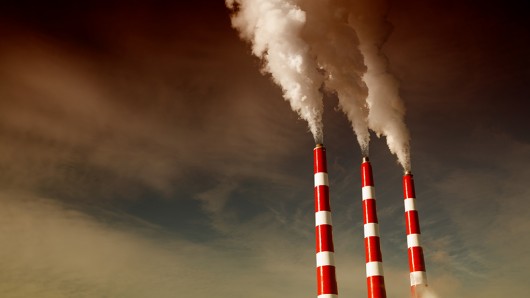Cryogenic treatment could cut coal-fired power plant emissions by 90%
By Darren Quick
August 27, 2012

Cooling the emissions from coal-fired power plants would significantly reduce the levels of dangerous chemicals entering the atmosphere (Photo: Shutterstock)
A team of physicists from the University of Oregon (UO) has calculated that cooling the emissions from coal-fired power plants would result in a reduction of the levels of dangerous chemicals entering the atmosphere, including CO2, by 90 percent. While cryogenic treatment would also see a 25 percent drop in efficiency, and therefore result in electricity costs increasing around a quarter, the researchers believe these would be offset by benefits to society, such as reductions in health-care and climate-change costs.
Previous studies, including one conducted in the 1970s by the Bechtel Corp. of San Francisco, have shown that cryogenic treatment of flue gases from coal-fired power plants can work. While the Bechtel study was looking at its effectiveness in capturing sulfur dioxide emissions, it also noted that large quantities of CO2 would also be condensed – something that didn’t warrant much attention back in the 70s but is of tremendous interest now.
Building on previous research he carried out in the 1960s into using cryogenic treatment technology as a way to remove odor-causing gases being emitted from a paper mill in Springfield, Oregon, UO physicist Russell J. Donnelly and his team have now composed a math-driven formula on an electronic spreadsheet that could be used by industry to weigh up the potential benefits of the technology.
UO physicist Russell J. Donnelly
The team’s paper says that CO2 condensed and captured as a solid would then be warmed and compressed into a gas that could be delivered via pipeline at near ambient temperatures to dedicated storage facilities that could be located hundreds of miles away. Additionally, other chemicals including sulfur dioxide, some nitrogen oxides and mercury would also be condensed so they could be safely removed from the gases emitted by the power plants.
The team’s calculations show that a cryogenic system would capture at least 90 percent on CO2, 98 percent of sulfur dioxide, and virtually 100 percent of mercury emissions. This is more than the capturing of 41 percent of sulfur dioxide and 90 percent of mercury emissions called for by the new mercury and air toxic standards (MATS) issued by the EPA in December 2011.
The team’s formula doesn’t take into account the cost of construction or retrofitting of the cooling machinery to existing power plants, which would be much larger than existing systems that use scrubbers – potentially as large as a football stadium. Nor does it take into account the cost of disposing of the captured pollutants. However, Donnelly thinks such systems are affordable, “especially with respect to the total societal costs of burning coal.”
“In the U.S., we have about 1,400 electric-generating unit(s) powered by coal, operated at about 600 power plants," Donnelly said. “That energy, he added, is sold at about 5.6 cents per kilowatt-hour, according to a 2006 Congressional Budget Office estimate. "The estimated health costs of burning coal in the U.S. are in the range of $150 billion to $380 billion, including 18,000-46,000 premature deaths, 540,000 asthma attacks, 13,000 emergency room visits and two million missed work or school days each year."
A separate, unpublished and preliminary economic analysis carried out by the team estimates that implementing large-scale cryogenic systems into coal-fired plants would see an overall reduction in costs to society of 38 percent through a sharp cut in associated health-care and climate-change costs.
The team’s paper appears in the journal Physical Review E.
Source: University of Oregon
Copyright © gizmag 2003 - 2012 To subscribe or visit go to: http://www.gizmag.com
